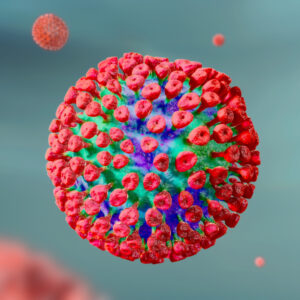Canine Parainfluenza Virus
Canine Parainfluenza virus (CPIV) is a highly contagious viral lung infection and one of the most common contributing causes of Kennel Cough (infectious tracheobronchitis), an acute or chronic inflammation of the respiratory airways.
Canine Parainfluenza Virus Background
Canine Parainfluenza virus (CPIV) is an enveloped, single-stranded RNA, negative sense virus belonging to the family Paramyxoviridae. The term parainfluenza was originally adopted after the influenza-like symptoms observed in infected patients and after the influenza-like hemagglutination and neuraminidase activities exhibited by the virus particles. First reported in the late 1960s in laboratory dogs, it is now thought to play a major role in kennel cough. CPIV was previously referred to as canine parainfluenza virus-2, and it is probably the same virus as simian virus 5, which was originally isolated from monkey cell cultures. As such, it has been suggested that it be renamed parainfluenza virus 5 (Chatziandreou et al., 2004).
CPIV infects dogs worldwide and is highly contagious; its prevalence in a given area is directly related to the density of the dog population. Therefore, outbreaks are common in shelters and kennels with a high population of animals. There is evidence that cats, hamsters and guinea pigs may naturally be infected with CPIV/SV5 or a very closely related virus and antibodies to CPIV have been demonstrated in 20 of 44 wildlife species in eight African countries (Hamblin & Hedger, 1978). Infection is typically limited to the upper respiratory tract and symptoms are mild, consisting of low-grade fever, dry cough, and pharyngitis. However, co-infection with another pathogen is common, resulting in a complicated form of disease. Symptoms can vary depending on the dog’s age and any weakened immunity due to age or an existing illness but include persistent cough, fever, nasal discharge, sneezing, eye inflammation, lethargy and loss of appetite.
CPIV is transmitted by means of airborne particles from coughing and sneezing and through contact with contaminated food bowls, water bowls and bedding. An infected dog can continue to pass on the virus for up to 2 weeks after recovery. When coupled with Bordetella bronchiseptica or canine adenovirus-2 (CAV-2), parainfluenza can contribute to the development of kennel cough (Buonavoglia & Martella, 2007). Treatments include antibiotics and antiviral medication. An effective vaccination is also available but may not provide protection against contracting the infection, although it can reduce the severity of the disease.
References
- Buonavoglia & Martella (2007). Canine respiratory viruses. Veterinary research 38.2, 355-373.
- Chatziandreou et al. (2004). Relationships and host range of human, canine, simian and porcine isolates of simian virus 5 (parainfluenza virus 5), J. Gen. Virol. 85:3007–3016.
- Hamblin C., Hedger R.S. (1978). Neutralising antibodies to parainfluenza 3 virus in African wildlife, with special reference to the Cape buffalo (Syncerus caffer), J. Wildl. Dis. 14:378-388.
- Paramyxoviridae and Pneumoviridae. In Fenner’s Veterinary Virology (Fifth Edition), 2017
- Parkinson et al. (1983). Survival of human parainfluenza viruses in the South Polar environment. Applied and environmental microbiology 46.4, 901-905.
Canine Parainfluenza Virus Antigens
We are please to offer an inactivated and purified Canine Parainfluenza Virus. This antigen is suitable for use in assay development, vaccine research and as antigens for the preparation of specific antibodies.
Questions?
Check out our FAQ section for answers to the most frequently asked questions about our website and company.

